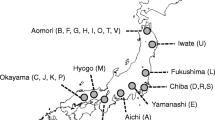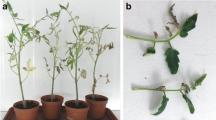Abstract
Specificity of a monoclonal antibody (MAb), Cmm1, to geographically diverse strains of the seed-borne tomato pathogen, Clavibacter michiganensis subsp. michiganensis (Cmm), was assessed and the MAb was tested for its usefulness as a tool to separate the pathogen from saprophytes in naturally infested tomato seed. Of the 236 international Cmm strains tested, 99% reacted with MAb Cmm1. MAb Cmm1 was also strongly reactive with an additional 32 strains isolated from seed that were later identified as Cmm by the Biolog MicroLog™ microbial identification system (Biolog, Inc., Hayward, CA) and 16S rDNA sequence analysis. It correctly differentiated these strains from 12 MAb Cmm1-negative seed strains that possessed similar colony morphology but were later identified as other Gram-positive genera and species. The specificity of MAb Cmm1 to the pathogen and the near universality of the MAb Cmm1-reactive antigen among diverse Cmm strains make this antibody a useful detection and identification tool. The finding that a large proportion of the Cmm strains associated with naturally infested tomato seed were putatively hypovirulent or non-virulent indicates that such populations cannot be ignored and points to a need for studies to determine their significance in host-pathogen interactions.
Similar content being viewed by others
References
Alvarez AM and Kaneshiro WS (1999) Detection and identification of Clavibacter michiganensis subsp. michiganensis in tomato seed. In: Sheppard JW (ed) Proceedings of the 3rd International Seed Testing Association Plant Disease Committee Seed Health Symposium, Iowa State University (pp. 93–97). The International Seed Testing Association, Zurich, Switzerland
Alvarez AM, Kaneshiro WS, Vine BG (2005) Diversity of Clavibacter michiganensis subsp. michiganensis populations in tomato seed: What is the significance? Acta Horticulturae 695: 205–213
Alvarez AM, Derie M, Benedict A, Gabrielson R (1993) Characteristics of a monoclonal antibody to Clavibacter michiganensis subsp. michiganensis. Phytopathology 83: 1405
Baer D, Gudmestad NC (1993) Serological detection of nonmucoid strains of Clavibacter michiganensis subsp. sepedonicus in potato. Phytopathology 83: 157–163
Benedict AA, Alvarez AM, Berestecky J, Imanaka W, Mizumoto CY, Pollard LW, Mew TW, Gonzalez CF (1989) Pathovar-specific monoclonal antibodies for Xanthomonas campestris pv. oryzae and for Xanthomonas campestris pv. oryzicola. Phytopathology 79: 322–328
Bermpohl A, Dreier J, Bahro R, Eichenlaub R (1996) Exopolysaccharides in the pathogenic interaction of Clavibacter michiganensis subsp. michiganensis with tomato plants. Microbiological Research 151: 391–399
Brumbley SM, Denny TP (1990) Cloning of wild-type Pseudomonas solanacearum phcA, a gene that when mutated alters expression of multiple traits that contribute to virulence. Journal of Bacteriology 172: 5677–5685
Carlson RR, Vidaver AK (1982) Taxonomy of Corynebacterium plant pathogens, including a new pathogen of wheat, based on polyacrylamide gel electrophoresis of cellular proteins. International Journal of Systematic Bacteriology 32: 315–326
Chang RJ, Ries SM, Pataky JK (1991) Dissemination of Clavibacter michiganensis subsp. michiganensis by practices used to produce tomato transplants. Phytopathology 81: 1276–1281
Chun WWC (1982) Identification and detection of Corynebacterium michiganense in tomato seed using the indirect enzyme-linked immunosorbent assay. MS Thesis. Honolulu, HI: University of Hawaii
Davis MJ, Gillaspie Jr. AG, Vidaver AK, Harris RW (1984) Clavibacter: A new genus containing some phytopathogenic coryneform bacteria, including Clavibacter xyli subsp. xyli sp. nov., subsp. nov. and Clavibacter xyli subsp. cynodontis subsp. nov., pathogens that cause ratoon stunting disease of sugarcane and bermudagrass stunting disease. International Journal of Systematic Bacteriology 34: 107–117
Dreier J, Bermpohl A, Eichenlaub R (1995) Southern hybridization and PCR for specific detection of phytopathogenic Clavibacter michiganensis subsp. michiganensis. Phytopathology 85: 462–468
European, Mediterranean Plant Protection Organization (2005) Clavibacter michiganensis subsp. michiganensis (PM 7/42[1]). Bulletin OEPP/EPPO Bulletin 35: 275–283
Fatmi M, Schaad NW (1989) Detection of Clavibacter michiganense subsp. michiganense in tomato seed. In: Saettler AW, Schaad NW, Roth DA (eds) Detection of Bacteria in Seed and Other Planting Material. APS Press, St. Paul, Minnesota, USA, pp. 45–49
Fulbright DW, Bell J, Medina-Mora C and Hausbeck MK (1998) Genotypic and phenotypic variation in field isolates of Clavibacter michiganensis subsp. michiganensis. In: Seventh International Congress of Plant Pathology, Edinburgh, UK (Abstract 2.2.91)
Gartemann K-H, Kirchner O, Engemann J, Gräfen I, Eichenlaub R, Burger A (2003) Clavibacter michiganensis subsp. michiganensis: First steps in the understanding of virulence of a Gram-positive phytopathogenic bacterium. Journal of Biotechnology 106: 179–191
Gitaitis RD, Beaver RW, Voloudakis AE (1991) Detection of Clavibacter michiganensis subsp. michiganensis in symptomless tomato transplants. Plant Disease 75: 834–838
Halk EL, De Boer SH (1985) Monoclonal antibodies in plant-disease research. Annual Review of Phytopathology 23: 321–350
Kaneshiro WS, Alvarez AM (2001) Specificity of PCR and ELISA assays for hypovirulent and avirulent Clavibacter michiganensis subsp. michiganensis. Phytopathology 91: S46
Louws FJ, Bell J, Medina-Mora CM, Smart CD, Opgenorth D, Ishimaru CA, Hausbeck MK, de Bruijn FJ, Fulbright DW (1998) rep-PCR-mediated genomic fingerprinting: A rapid and effective method to identify Clavibacter michiganensis. Phytopathology 88: 862–868
Meletzus D, Bermpohl A, Dreier J, Eichenlaub R (1993) Evidence for plasmid-encoded virulence factors in the phytopathogenic bacterium Clavibacter michiganensis subsp. michiganensis NCPPB382. Journal of Bacteriology 175: 2131–2136
Norman D, Alvarez AM (1989) A rapid method for presumptive identification of Xanthomonas campestris pv. dieffenbachiae and other xanthomonads. Plant Disease 73: 654–658
Sousa Santos M, Cruz L, Norskov P, Rasmussen OF (1997) A rapid and sensitive detection of Clavibacter michiganensis subsp. michiganensis in tomato seeds by polymerase chain reaction. Seed Science and Technology 25: 581–584
Suslow TV, Schroth MN, Isaka M (1982) Application of a rapid method for Gram differentiation of plant pathogenic and saprophytic bacteria without staining. Phytopathology 72: 917–918
Strider DL (1969) Bacterial canker of tomato caused by Corynebacterium michiganense. A literature review and bibliography. North Carolina Agricultural Experiment Station Technical Bulletin No. 193
van den Bulk RW, Zevenhuizen LPTM, Cordewener JHG, Dons JJM (1991) Characterization of the extracellular polysaccharide produced by Clavibacter michiganensis subsp. michiganensis. Phytopathology 81: 619–623
van Vuurde JWL (1990) Immunofluorescence colony staining. In: Hampton R, Ball E, De Boer S (eds) Serological Methods for Detection and Identification of Viral and Bacterial Plant Pathogens. APS Press, St. Paul, Minnesota, USA, pp. 299–305
Veena MS, van Vuurde JWL (2002) Indirect immunofluorescence colony staining method for detecting bacterial pathogens of tomato. Journal of Microbiological Methods 49: 11–17
Werner NA (2001) Genomic variation and control of Clavibacter michiganensis subsp. michiganensis in Michigan. MS Thesis. Ann Arbor, MI: Michigan State University
Wilson EE, Zeitoun FM, Fredrickson DL (1967) Bacterial phloem canker, a new disease of Persian walnut trees. Phytopathology 57: 618–621
Acknowledgements
This paper is dedicated to the late Dr. Albert Benedict, who contributed greatly to the production and characterization of these and other monoclonal antibodies for numerous bacterial plant pathogens. Many thanks go to German Hoyos (Syngenta Seeds), Mark Ricker and Bert Woudt for generously providing the infested seed lots used in this study. This work was supported by grants from the United States Department of Agriculture Tropical and Subtropical Agricultural Research Grants Programme (Award No. 2003-34135-13982) and the American Seed Research Foundation Vegetable and Flower Seed Division Permanent Research Fund.
Author information
Authors and Affiliations
Corresponding author
Rights and permissions
About this article
Cite this article
Kaneshiro, W.S., Mizumoto, C.Y. & Alvarez, A.M. Differentiation of Clavibacter michiganensis subsp. michiganensis from seed-borne saprophytes using ELISA, Biolog and 16S rDNA sequencing. Eur J Plant Pathol 116, 45–56 (2006). https://doi.org/10.1007/s10658-006-9036-1
Accepted:
Published:
Issue Date:
DOI: https://doi.org/10.1007/s10658-006-9036-1




